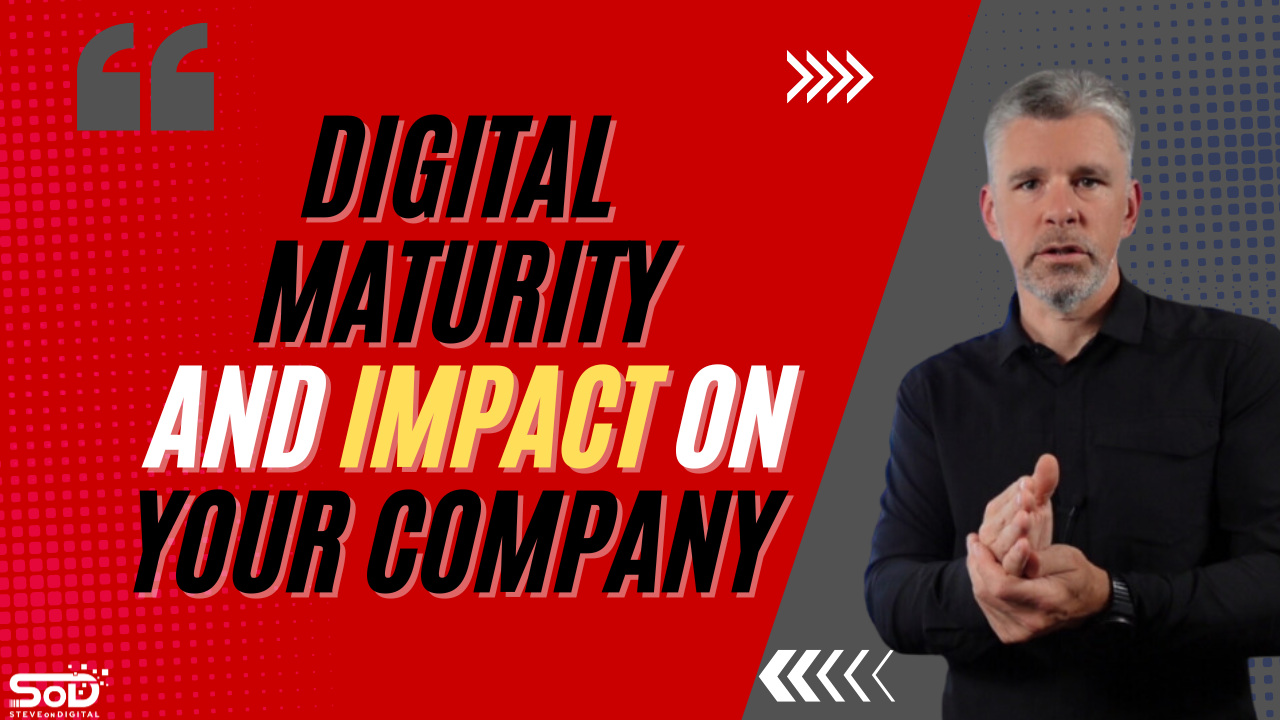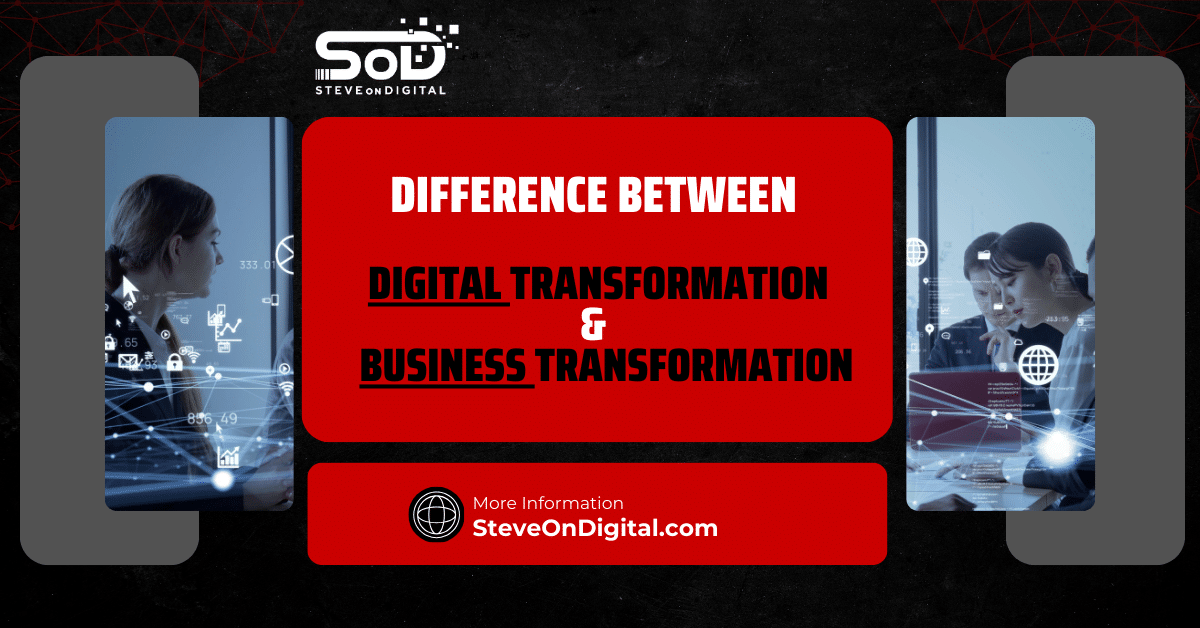Management support is crucial for successful digital transformation. Without strong leadership backing, even the most well-planned digital transformation initiatives can fail. Management’s involvement ensures that digital technologies are effectively integrated into business processes, aligning with the company’s goals.
Digital transformation is not just about technology; it’s about changing how a business operates and delivers value. From setting clear objectives to engaging employees, management plays a key role in driving this change. In my experience, businesses that have strong management support during digital transformation are more likely to achieve their goals and sustain long-term success.
I’m Steve, a digital transformation expert with a strong background in electrical engineering, an MBA, and a master’s in Project Management. I excel at helping SMEs navigate the digital landscape with practical insights. Let’s begin!
The Role of Management in Digital Transformation
Management plays a pivotal role in the success of digital transformation initiatives. From my experience, without strong management support, even the most well-thought-out digital strategy can fail. Management’s involvement is not just necessary; it’s the cornerstone of a successful digital transformation.
Importance of Management Support
Why is management support so crucial? It’s simple. Management sets the tone for the entire organization. If the management team is fully on board with the digital transformation, it creates a ripple effect throughout the company. Employees are more likely to embrace change when they see that the leadership is committed and invested. Moreover, management support helps in aligning the digital transformation with the overall business strategy, ensuring that every digital initiative contributes to the company’s long-term goals.
Statistics back this up. According to a study published in the MIT Sloan Management Review, companies with strong management support for digital transformation are 26% more likely to achieve their digital goals compared to those without such support. This underscores the vital role that management plays in steering the ship during a digital transformation.
Management’s Role in Digital Strategy
The role of management in digital strategy extends beyond just giving a nod of approval. Management must actively participate in the planning and execution of the digital transformation strategy. This includes setting clear objectives, allocating resources, and ensuring that the digital initiatives align with the company’s business model. I’ve seen companies succeed when their leaders took an active role in digital strategy, from the planning phase to implementation.
A successful digital transformation requires management to understand both the potential and the limitations of digital technologies. It’s about making informed decisions that will have a positive impact on the business processes. For instance, during one of my consulting projects, a client’s management team was fully engaged in the digital transformation process, which resulted in a 15% increase in operational efficiency within the first year. This kind of result is only possible when management is actively involved in every step of the digital strategy.
Case Study Overview
To illustrate the impact of management on digital transformation, let’s look at a real-world example. The Digirati group, as mentioned earlier, is a prime example of a company that has successfully navigated its digital transformation journey thanks to strong management support. In this case, management not only supported the transformation but also drove it by making informed decisions and setting clear business objectives. The result? A significant increase in both revenue and market value, outperforming competitors who invested more in technology but lacked strong management support.
This case study clearly shows that management intensity, more than just digital intensity, is the key to a successful transformation. The takeaway here is that without management support, even the best digital technologies will fall short.
Understanding Digital Transformation
To truly grasp the importance of digital transformation, it’s essential to understand what it entails and why it’s critical for businesses today.
What is Digital Transformation?
Digital transformation involves integrating digital technologies across every aspect of a business, fundamentally reshaping how the company functions and delivers value to its customers. It’s not just about digitizing existing processes but rethinking and redesigning them to take full advantage of new digital capabilities. This transformation is an ongoing process, not a one-time event, requiring continuous learning and adaptation to stay competitive in the digital age.
In my years of working with various businesses, I’ve seen that successful digital transformation requires more than just technology. It demands a shift in mindset across the entire organization. Business leaders must be willing to embrace change and lead by example. This is where management support in digital transformation becomes crucial.
Digital Transformation vs. Digitalization
It’s important to differentiate between digital transformation and digitalization. Digitalization refers to the process of using digital technologies to change a business model and provide new revenue and value-producing opportunities. Digital transformation, on the other hand, goes beyond digitalization. It involves a cultural change that requires organizations to continually challenge the status quo, experiment, and get comfortable with failure.
While digitalization might be the first step, digital transformation is the comprehensive overhaul of a company’s operations and strategy. For example, simply moving paper-based processes online is digitalization. However, when a company rethinks its entire customer experience from the ground up to integrate digital technology at every touchpoint, that’s digital transformation.
Common Myths About Digital Transformation
There are several misconceptions about digital transformation that I’ve encountered during my work. One of the most common myths is that digital transformation is all about technology. While technology is a significant component, it’s not the only factor. Successful digital transformation also requires a change in company culture, processes, and management support.
Another myth is that digital transformation is a one-time project. In reality, it’s an ongoing process that requires continuous innovation and adaptation. Businesses must be prepared to evolve as new technologies emerge and market conditions change. The digital era is constantly evolving, and companies that fail to keep up risk falling behind.
Finally, some believe that digital transformation is only for large enterprises. This couldn’t be further from the truth. Small businesses can also benefit greatly from digital transformation by leveraging digital technologies to improve efficiency, enhance customer satisfaction, and drive growth. In fact, small businesses often have the advantage of being more agile and able to implement changes more quickly than larger organizations.
Key Elements of Successful Digital Transformation
Embarking on a digital transformation journey can be daunting, but understanding its essential components makes the process smoother. From technology adoption to management strategies, several factors determine the success of a digital transformation. Let me walk you through these critical elements.
Technology Adoption
Technology adoption is the backbone of digital transformation. Integrating new technologies into your existing business processes is essential for staying competitive. I’ve observed that companies often struggle with choosing the right technology that aligns with their business goals. The key here is to adopt technologies that not only enhance current processes but also provide room for future growth.
For instance, adopting artificial intelligence can significantly improve decision-making processes, leading to more efficient operations. But it’s crucial to ensure that the technology is implemented in a way that supports your overall digital transformation initiatives. According to a report from McKinsey, companies that fully leverage digital technologies are 2.3 times more likely to achieve their financial goals.
Change Management Strategy
Change management is where the rubber meets the road in digital transformation. A well-defined change management strategy is critical to overcoming resistance and ensuring a smooth transition. I’ve seen businesses fail at digital transformation because they underestimated the human factor. Employees need to be guided through the change process, and this is where a robust change management strategy comes in.
A successful change management strategy involves clear communication, engaging key stakeholders, and providing the necessary training. It’s about reducing resistance to change by empowering employees and making them feel involved in the transformation process. A study by Prosci indicates that projects with excellent change management are six times more likely to meet or exceed their objectives.
Continuous Learning and Development
In the digital age, continuous learning and development are not just nice to have—they’re essential. The rapid pace of technological advancements means that skills can quickly become outdated. To stay ahead, businesses need to foster a culture of continuous learning and development. This involves not just training programs but also encouraging employees to stay curious and open to new ideas.
Training Programs
Effective training programs are the cornerstone of continuous learning. They help employees develop the digital skills needed to navigate new technologies and processes. I’ve found that companies that invest in comprehensive training programs experience smoother digital transformations and higher employee satisfaction.
For example, one company I worked with developed a training program that combined online courses with in-person workshops. This approach not only improved digital literacy but also built a sense of community among employees, making them more receptive to the changes.
Encouraging Continuous Improvement
Continuous improvement is the lifeblood of a successful digital transformation. It’s not enough to implement new technologies and call it a day; businesses must continually assess and refine their processes. Encouraging a culture of continuous improvement keeps the momentum going and ensures that the organization remains agile in the face of change.
One way to foster this culture is by setting up feedback loops where employees can share their experiences and suggest improvements. This not only enhances processes but also empowers employees by giving them a voice in the transformation.
Management Intensity in Digital Transformation
Management intensity is often the deciding factor between success and failure in digital transformation. It’s about how much effort and resources management is willing to invest in driving the transformation forward. Let’s break down why management intensity matters so much.
Digital Intensity vs. Management Intensity
There’s a common misconception that digital intensity—how much a company invests in digital technologies—is the most critical factor in digital transformation. However, my experience shows that management intensity—how involved and committed management is—can be even more crucial.
A study published in the MIT Sloan Management Review found that companies with high management intensity are more likely to achieve a successful transformation, even if their digital intensity is not as high. This suggests that management’s commitment can compensate for lower technology investment by ensuring that the digital transformation aligns with the company’s business strategy and goals.
Impact on Revenue Growth
Management intensity has a direct impact on revenue growth during digital transformation. Companies where management takes an active role in the transformation process tend to see more significant revenue growth. This is because management is better positioned to align digital initiatives with revenue-generating activities.
For instance, in one of the projects I worked on, the company’s management team was heavily involved in integrating digital technologies into their marketing and sales processes. The result was a 20% increase in revenue within the first year of the transformation. This kind of outcome is only possible when management is fully committed to the process.
Impact on Profit Margins
Profit margins are another area where management intensity makes a significant difference. Companies with strong management support tend to see better profit margins during and after a digital transformation. This is because management can ensure that the transformation is cost-effective and aligned with the company’s financial goals.
Case Study: Digirati
The Digirati group serves as a prime example of the impact of management intensity on digital transformation. In this case, management not only supported but drove the transformation by making informed decisions and aligning the digital initiatives with clear business objectives. The result was a substantial increase in both profit margins and market value, demonstrating the importance of management involvement.
Impact on Market Value
Management intensity also plays a crucial role in influencing market value during a digital transformation. Companies with strong management support tend to see an increase in their market value, as investors and stakeholders gain confidence in the company’s ability to navigate the digital era successfully.
In my experience, when management takes a proactive role in digital transformation, it sends a positive signal to the market. It shows that the company is not just adopting new technologies but is also committed to leveraging those technologies to drive long-term growth and value creation.
Developing a Digital Transformation Strategy
A well-crafted digital transformation strategy is essential for guiding your business through the complexities of change. Here’s how to develop a strategy that sets your company up for success.
Setting Clear Objectives
The first step in developing a digital transformation strategy is setting clear objectives. These objectives should align with your business goals and provide a roadmap for your digital initiatives. In my work, I’ve found that companies that take the time to define clear, measurable objectives are more likely to achieve a successful transformation.
For example, if your goal is to improve customer satisfaction, your digital transformation initiatives should focus on enhancing the customer experience through digital channels. This might involve implementing new communication channels or improving your internal social media strategy.
Involving Key Stakeholders
Digital transformation is not a solo effort. It requires the involvement of key stakeholders from across the organization. Involving stakeholders early in the process ensures that everyone is on the same page and that the transformation aligns with the needs and expectations of different business units.
I’ve seen transformations fail because key stakeholders were not involved in the planning phase. To avoid this, make sure to engage with business leaders, IT departments, and other relevant parties from the outset. This collaborative approach increases the likelihood of a smooth and successful transformation.
Continuous Innovation
In the digital age, innovation is not a one-time event; it’s a continuous process. Encouraging continuous innovation ensures that your company stays ahead of the curve and remains competitive in an ever-evolving market.
Building Agile Teams
One way to foster continuous innovation is by building agile teams. Agile teams are small, cross-functional groups that can quickly adapt to changes and implement new ideas. In my experience, agile teams are essential for driving digital transformation initiatives, as they allow the company to be more responsive to market changes and customer needs.
Implementing Digital Governance
Digital governance is another critical component of a successful digital transformation strategy. It ensures that all digital initiatives are aligned with your company’s business goals and that there is a clear framework for decision-making.
Implementing digital governance involves setting up processes and guidelines for how digital technologies are adopted and used within the organization. This helps to prevent any misalignment between your digital transformation initiatives and your overall business strategy.
Overcoming Challenges in Digital Transformation
Digital transformation is not without its hurdles. I’ve faced several challenges in guiding businesses through this journey. Understanding and addressing these challenges can be the difference between a successful transformation and a failed one. Let’s dive into some of the most common obstacles and how to overcome them.
Resistance to Change
One of the biggest challenges in digital transformation is resistance to change. I’ve seen this play out in many organizations where employees are comfortable with the existing processes and skeptical about adopting new technologies. This resistance often stems from fear—fear of the unknown, fear of losing their jobs, or simply fear of change.
To manage and reduce this resistance, it’s essential to engage employees from the start. I’ve found that involving them in the planning phase, explaining the benefits of the transformation, and providing adequate training can help ease their concerns. According to a study by McKinsey, transformations where employees feel included and supported are 1.5 times more likely to succeed. It’s crucial to create a culture that embraces change rather than fears it.
Balancing Technology and Human Factors
Digital transformation is not just about technology; it’s about people. Balancing new technologies with the human aspect of business processes is critical. I’ve encountered situations where companies focus too much on the technology and neglect the impact it has on their employees. This can lead to frustration and even burnout among staff.
The key is to strike a balance. While it’s important to adopt new technologies, you must also consider how these changes will affect your employees. In my experience, the most successful digital transformations are those that integrate new technologies in a way that enhances, rather than disrupts, existing business processes. This requires clear communication, ongoing training, and a focus on employee well-being.
Managing Cultural Change
Cultural change is another significant challenge during digital transformation. I’ve noticed that organizations with a rigid culture often struggle to adapt to new ways of working. Managing this cultural shift requires a strategic approach. It’s not just about introducing new tools or processes; it’s about changing the way people think and work.
Communication Plan
A clear communication plan is essential for managing cultural change. I’ve seen how effective communication can make or break a digital transformation. Your communication plan should keep everyone informed about what’s happening, why it’s happening, and how it will affect them. Regular updates, open forums for discussion, and transparent decision-making processes are key to keeping everyone on the same page.
Employee Feedback
Another crucial aspect of managing cultural change is leveraging employee feedback. Feedback provides valuable insights into how the transformation is being received and where adjustments may be needed. I always encourage businesses to create channels for employees to share their thoughts and experiences during the transformation. This not only helps in refining the process but also makes employees feel valued and involved.
The Role of IT in Digital Transformation
The IT department is the engine that drives digital transformation. Without their support, any digital transformation initiative is likely to falter. Let’s explore how IT can support and accelerate your digital transformation efforts.
IT-Business Collaboration
Collaboration between IT and business units is essential for a successful transformation. I’ve seen projects fail simply because there was a disconnect between what the business wanted and what IT delivered. Bridging this gap requires ongoing communication and collaboration.
From my experience, the most successful transformations occur when IT and business units work together from the start. This ensures that the digital transformation initiatives are aligned with business objectives and that the technologies implemented are fit for purpose. A survey by Gartner found that organizations with strong IT-business collaboration are 2.5 times more likely to achieve digital transformation success.
Integrating New Technologies
Integrating new technologies into existing business processes is no small feat. It requires careful planning and execution. One common mistake I’ve seen is businesses rushing to implement new technologies without considering how they will integrate with existing systems. This often leads to inefficiencies and frustration.
The best approach is to take it step by step. Start by assessing your existing processes and identifying areas where new technologies can add value. Then, work closely with your IT department to ensure a smooth integration. This might involve upgrading legacy systems, developing custom solutions, or even changing some business processes to better fit the new technology.
Ensuring Data Security
Data security is a top concern during digital transformation. As businesses adopt new technologies, they often expose themselves to new risks. I’ve worked with companies that neglected data security in their rush to go digital, only to face significant issues down the line.
Maintaining data security during digital transformation requires a proactive approach. This includes implementing robust security measures, regularly auditing systems for vulnerabilities, and training employees on best practices. In today’s digital age, data security is not just an IT responsibility; it’s a business imperative. According to a report by Accenture, companies that prioritize data security during their digital transformation are 33% less likely to experience a major security breach.
Change Management in Digital Transformation
Change management is the glue that holds a digital transformation together. Without a solid change management plan, even the best-laid plans can fall apart. Here’s how to approach change management in your digital transformation.
Creating a Change Management Plan
A comprehensive change management plan is the first step to ensuring a smooth transformation. I’ve seen many businesses underestimate the importance of this step, only to face significant challenges later on. Your plan should outline the steps needed to manage the transition, address potential resistance, and ensure that everyone is on board.
A good change management plan includes clear objectives, a timeline, a communication strategy, and a plan for training and development. It’s also essential to identify potential obstacles and have contingency plans in place. A well-thought-out change management plan can be the difference between a smooth transition and a rocky one.
Training and Development
Training and development are critical components of change management. Employees need to be equipped with the skills and knowledge to navigate the new processes and technologies. I’ve found that companies that invest in comprehensive training programs are more likely to see a successful transformation.
Training should be continuous, not just a one-time event. As the digital transformation progresses, new skills may be required, and employees need to be kept up to date. Providing ongoing training and development opportunities shows employees that they are valued and that the company is invested in their success.
Monitoring Progress
Finally, it’s crucial to monitor the progress of your change management efforts. This involves regularly checking in on how the transformation is progressing, gathering feedback, and making adjustments as needed. In my experience, monitoring progress helps identify issues early on and allows for course corrections before they become major problems.
One effective way to monitor progress is by setting up key performance indicators (KPIs) that track the success of your change management initiatives. These might include metrics like employee engagement, training completion rates, and the overall adoption rate of new technologies. By keeping a close eye on these indicators, you can ensure that your digital transformation stays on track.
Measuring the Success of Digital Transformation
Understanding whether your digital transformation efforts are successful is crucial. Without proper metrics and evaluation techniques, it’s impossible to know if your initiatives are on the right track. In my experience, measuring success goes beyond just looking at the bottom line; it’s about understanding the broader impact on your business and customers.
Key Performance Indicators (KPIs)
Key Performance Indicators (KPIs) are the metrics that help you track the progress and success of your digital transformation. Identifying the right KPIs is essential to measure how well your digital transformation initiatives align with your business goals.
For instance, I often recommend focusing on KPIs such as operational efficiency, customer satisfaction, and employee engagement. These indicators provide a holistic view of how the transformation is impacting different parts of your business. According to Gartner, businesses that regularly monitor their KPIs during digital transformation are 60% more likely to achieve their strategic objectives.
When setting KPIs, it’s essential to ensure they are specific, measurable, achievable, relevant, and time-bound (SMART). This approach helps in maintaining clarity and focus throughout the transformation process.
Assessing Business Impact
The impact of digital transformation on various business areas needs careful assessment. It’s not just about whether you’ve adopted new technologies, but how these technologies are affecting your existing business processes and overall business model.
One way to assess this impact is by conducting regular reviews of your business processes. I’ve found that businesses that take the time to analyze how digital transformations have altered their workflows and business units often discover new opportunities for efficiency and innovation. For example, a company I worked with was able to reduce its operational costs by 20% after reevaluating its processes post-transformation.
Another critical aspect is evaluating the financial impact. This includes looking at revenue growth, profit margins, and market share. But beyond financials, it’s also about understanding the non-financial benefits like improved customer satisfaction and employee morale.
Customer Satisfaction
Customer satisfaction is one of the most telling indicators of a successful digital transformation. If your customers are happier and more engaged because of the changes you’ve implemented, that’s a clear sign of success.
Measuring customer satisfaction can be done through surveys, feedback forms, and customer reviews. I always emphasize the importance of listening to your customers during and after a transformation. Their feedback is invaluable in refining your digital strategies and ensuring they meet their needs. According to a report by Deloitte, companies that prioritize customer satisfaction during digital transformation see a 30% increase in customer loyalty.
The Future of Digital Transformation
Digital transformation is not a one-time event; it’s a continuous process that evolves with new technologies and market trends. As I look towards the future, several emerging trends and technologies stand out as game-changers.
Emerging Technologies
The future of digital transformation will be shaped by emerging technologies like artificial intelligence (AI), blockchain, and the Internet of Things (IoT). These technologies have the potential to revolutionize how businesses operate and interact with customers.
For example, AI is already playing a significant role in enhancing customer experience through personalized recommendations and chatbots. Meanwhile, blockchain is poised to transform supply chain management by increasing transparency and reducing fraud. IoT, on the other hand, is enabling businesses to collect real-time data from connected devices, providing deeper insights into customer behavior and business operations.
Keeping an eye on these emerging technologies and being open to integrating them into your business processes will be crucial for staying competitive in the digital age.
Continuous Process
As I’ve mentioned before, digital transformation is an ongoing process. It’s not something that you can set and forget. Continuous innovation and adaptation are necessary to keep up with the fast pace of technological advancements and changing customer expectations.
Businesses that view digital transformation as a continuous process are more likely to succeed in the long term. This involves regularly revisiting your digital strategy, assessing the effectiveness of your digital technologies, and being willing to pivot when necessary. A McKinsey study found that companies that embrace continuous digital transformation are twice as likely to be in the top quartile of their industry in terms of performance.
Preparing for the Future
Preparing for the future means being proactive rather than reactive. I’ve seen too many businesses fall behind because they were slow to adapt to new trends or technologies. To avoid this, it’s important to stay informed about the latest developments in digital transformation and be ready to implement changes when necessary.
This preparation also involves upskilling your workforce to handle new technologies and processes. Continuous learning and development should be a priority to ensure your team is equipped to navigate the digital age. In addition, fostering a culture of innovation and agility within your organization will help you stay ahead of the curve.
Final Thoughts
Digital transformation is a journey, not a destination. It requires careful planning, strong management support, and a willingness to embrace change. Throughout this blog post, I’ve shared insights and strategies to help you navigate this complex process. Whether it’s understanding the key elements of a successful transformation, overcoming common challenges, or preparing for the future, the role of management support in digital transformation cannot be overstated.
As I’ve learned from my own experiences, the businesses that thrive in the digital era are those that view digital transformation as an ongoing, dynamic process. By staying engaged, measuring success, and being open to innovation, you can ensure that your digital transformation efforts lead to long-term success and growth.




